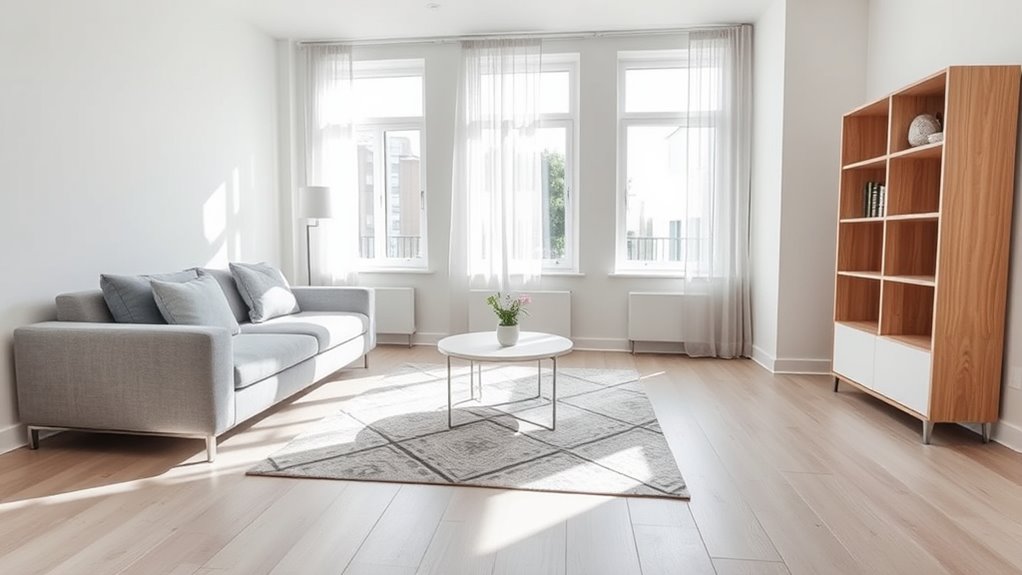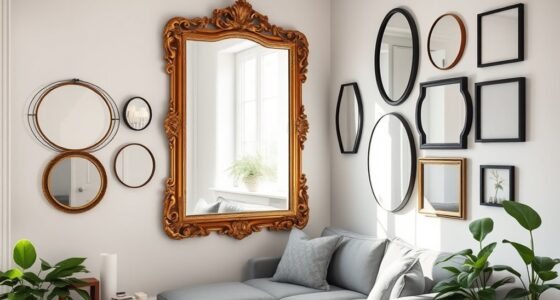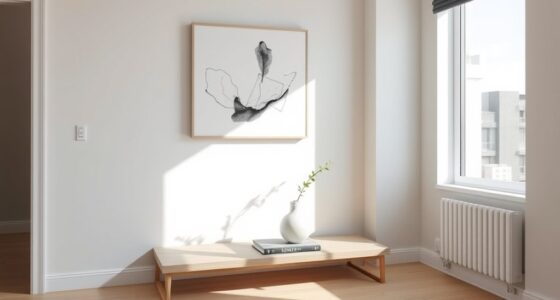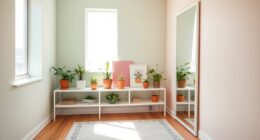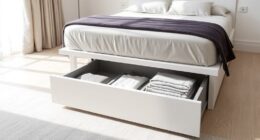To maximize space in your small living room, focus on creating a clear focal point like a fireplace or large window, and arrange furniture to promote flow, using open-frame and multi-functional pieces. Incorporate light colors, reflective surfaces, and transparent furniture to make the space feel larger and brighter. Use vertical storage and define zones with rugs to maintain organization. Keep calm and cohesive—continue exploring these ideas for a more spacious, inviting living area.
Key Takeaways
- Use open-frame, multi-functional furniture with built-in storage to maximize utility and reduce visual clutter.
- Arrange furniture facing focal points and create clear traffic paths to enhance flow and space perception.
- Incorporate vertical storage solutions like tall shelves and wall-mounted organizers to free up floor space.
- Select light-colored furniture and reflective surfaces, such as mirrors and glass, to bounce light and visually expand the room.
- Define zones with appropriately sized area rugs and consistent color schemes to create a sense of order and openness.
Incorporate a Focal Point
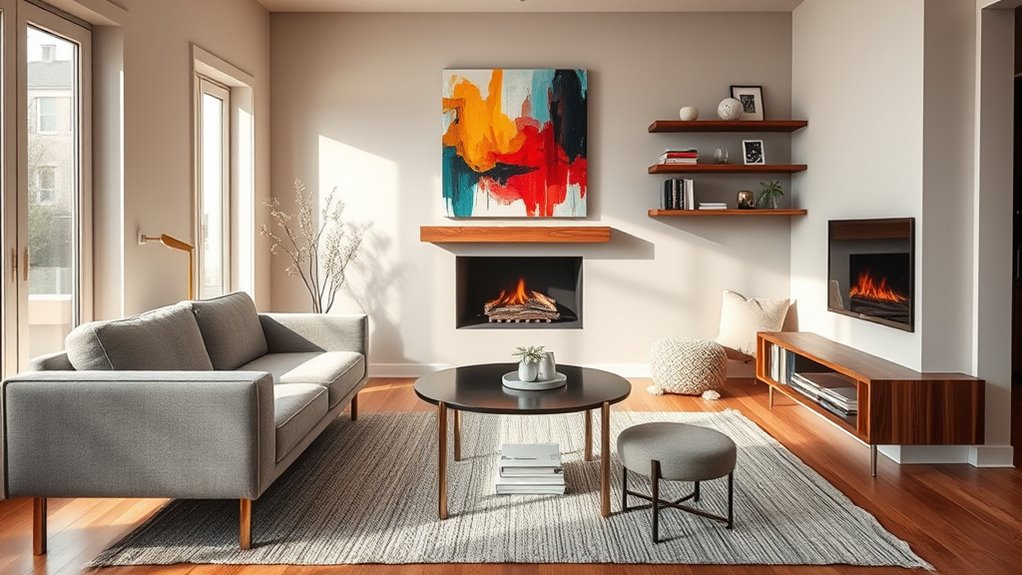
Creating a small living room feels more spacious when you incorporate a clear focal point. This helps establish a strong room layout and creates visual balance, making the space feel larger. Choose a focal point like a fireplace, TV, or large window to anchor the space. Incorporate vintage decor or rustic accents to add character and charm to the focal area. Enhance it with statement artwork or a bold area rug that draws attention and guides the eye. Arrange your furniture to face or surround this feature, improving flow and usability. Good lighting, such as sconces or accent lamps, highlights your focal point and adds warmth, making the room inviting. Position key decor elements around this feature to emphasize it further. Utilizing natural light can also make a small space feel more open and airy. Incorporating multi-functional furniture can further maximize space and functionality in your small living room. Understanding space planning is essential to create a balanced and practical layout that feels spacious despite limited square footage. Additionally, integrating light-colored walls can visually expand the room and enhance the sense of openness. This approach ensures your living room feels cohesive and well-designed, even in a compact space.
Optimize Furniture Placement for Flow
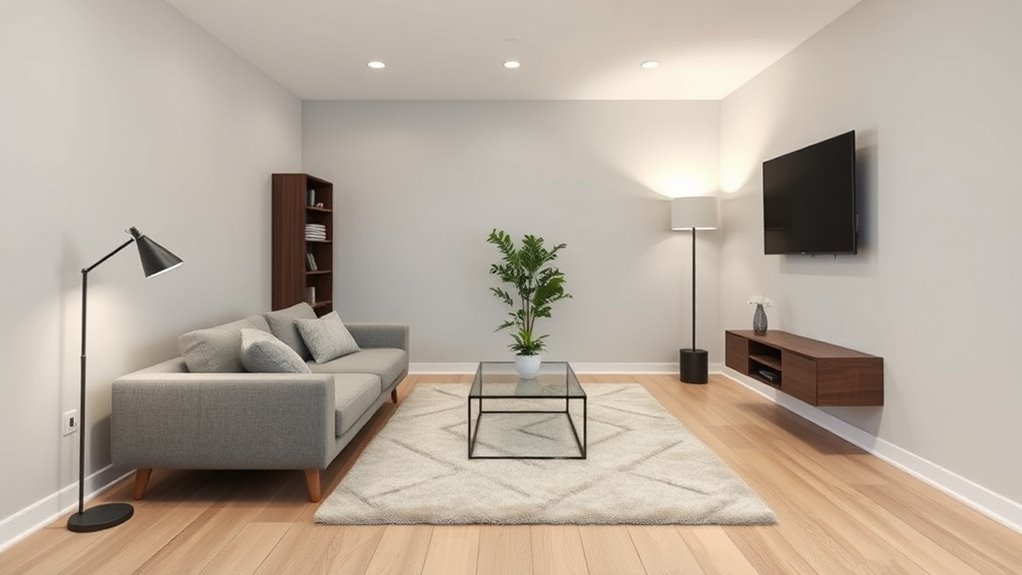
To make the most of your small living room, focus on optimizing furniture placement to enhance flow and accessibility. Avoid pushing furniture against walls; instead, group sofas and chairs in the center to create cozy zones and improve room flow. Design traffic paths around key furniture pieces to prevent congestion and maintain easy movement. Use symmetrical or parallel furniture arrangements, like facing couches, to foster conversation and balance. Incorporate multi-functional pieces, such as ottomans with storage or fold-away tables, to maximize utility without cluttering pathways. Position larger furniture, like sectionals with central coffee tables, to define zones within open-concept layouts. Proper furniture arrangement guarantees smooth traffic flow and clear zone definition, making your small living room feel open and inviting. Additionally, considering safety and quality considerations ensures that your furniture not only looks good but also remains durable and safe for everyday use. To further optimize space, incorporating creative storage solutions can keep clutter at bay and enhance overall functionality.
Use Light, Transparent, and Reflective Furniture
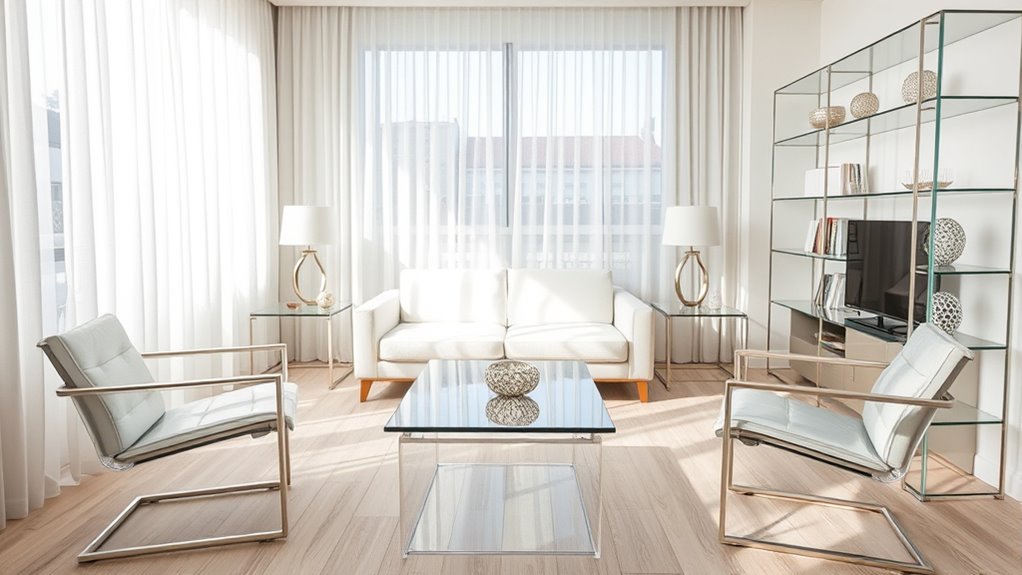
Using light, transparent, and reflective furniture can make your small living room feel more open and airy. Acrylic and glass pieces, along with reflective decor, bounce light around the space, creating the illusion of more room. Incorporating clutter-free storage solutions helps maintain a clean and open appearance, further enhancing the sense of spaciousness. Additionally, choosing appropriate lighting can accentuate these effects and make the room feel even larger. Implementing visual balance through strategic placement of furniture and decor can further optimize the perception of space. Incorporating multi-functional furniture can also maximize utility without cluttering the room. Pairing these with light-colored upholstery enhances the sense of brightness and openness.
Acrylic and Glass Pieces
In small living rooms, incorporating acrylic and glass pieces can make a significant difference by enhancing the sense of openness. Acrylic furniture, like coffee tables and side tables, offers a light, transparent look that creates an open layout and visually expands the space. Energetic alignment with your environment through these elements can also promote a more harmonious and uplifting atmosphere. Glass decor and transparent shelving maximize storage without blocking light or cluttering the room. Reflective surfaces, such as mirrors or glass accessories, bounce natural light around the space, making it feel brighter and larger. These elements reduce visual weight, improve sightlines, and contribute to a more organized, airy environment. Choosing the right placement and size of these pieces can optimize their spatial impact and further enhance the spacious feel. Incorporating reflective surfaces strategically can also amplify natural light and create a more inviting atmosphere. Additionally, understanding how attention can be cultivated through consistent use of these elements helps in maintaining a calming and focused environment. Employing lightweight, energy-efficient acrylic and glass pieces not only maximizes space but also minimizes energy consumption, aligning with sustainable living practices. By selecting clear, reflective pieces, you allow light and space to flow freely, transforming your small living room into a more inviting and spacious area.
Reflective Wall Decor
Reflective wall decor can instantly brighten and expand a small living room by bouncing natural light throughout the space. Incorporate mirrored decor like wall-mounted mirrors or mirrored cabinets to enhance light reflection and create a sense of space illusion. Utilizing natural lighting can further amplify these effects, making the room feel even more open and inviting. Placing mirrors opposite windows or light sources maximizes their effect, amplifying brightness and depth. Reflective surfaces on walls, ceilings, or furniture help diffuse light evenly, reducing visual clutter and making the room feel larger. Combining these elements with strategic lighting placement boosts the perception of space and adds visual weightlessness. Additionally, choosing reflective surfaces that are easy to clean ensures the space remains bright and inviting over time. Incorporating light-colored decor can also reflect more light, enhancing the overall luminous effect. Recent advances in AI-powered technology can assist in selecting the best placement and decor style, ensuring your small living room feels more spacious and personalized. Understanding the importance of tableware and its role in social settings can also inspire decorative choices that complement your space. By embracing mirrored decor and reflective surfaces, you transform a cramped area into an airy, open environment that feels more spacious and inviting without sacrificing style.
Light-Colored Upholstery
Choosing light-colored upholstery like white, cream, or beige instantly makes a small living room feel more spacious by reflecting natural light and creating an airy atmosphere. Light upholstery boosts brightness and makes the space feel open.
Pairing it with transparent furniture, such as acrylic or glass pieces, enhances the sense of openness and prevents cluttered visuals. Incorporate reflective surfaces like mirrored coffee tables or decor to amplify natural light and give the illusion of a larger room.
Open-frame furniture with minimal design reduces visual weight, making your small living space feel less cramped.
Strategically combining light upholstery with reflective and transparent elements creates a bright, inviting environment that maximizes your room’s perceived size and comfort.
Maximize Vertical Storage Solutions
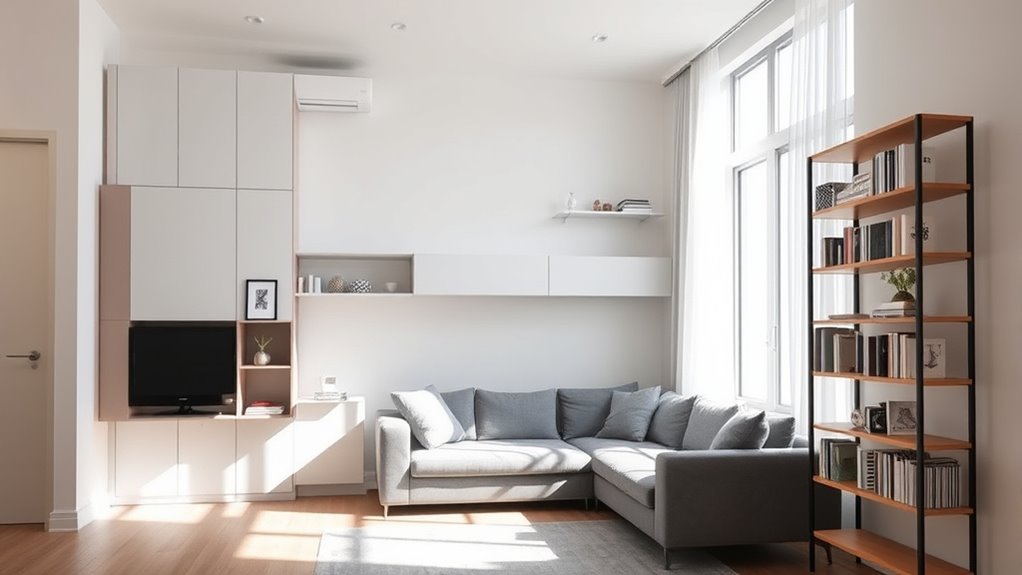
To make the most of your small living room, consider vertical storage options like floor-to-ceiling shelves or tall cabinets that free up floor space. Wall-mounted organizers and floating shelves add extra storage without cluttering the room. Using these solutions helps keep things organized while making your space feel larger and more open. Incorporating automation technologies can further streamline your space management and enhance overall efficiency.
Floor-to-Ceiling Shelving
Maximizing vertical space is a smart way to add storage without cluttering a small living room. Floor-to-ceiling shelving takes advantage of your wall height, providing ample storage for books, decor, and organization essentials.
Wall-mounted shelves or tall bookcases help draw the eye upward, creating the illusion of a larger, more open space. Custom-built or adjustable options give you flexibility to fit your needs and room dimensions perfectly.
Incorporating decorative baskets or boxes on these shelves offers accessible storage while maintaining an organized look. This approach keeps your living area tidy and functional without sacrificing style.
With floor-to-ceiling shelving, you optimize your vertical space efficiently, making your small living room feel more spacious and well-organized.
Wall-Mounted Organizers
Wall-mounted organizers are an effective way to keep your small living room tidy by utilizing vertical space. With wall-mounted storage like shelves and pegboards, you can free up floor area while adding functional storage. These solutions help reduce clutter by holding books, decorative items, or kitchen essentials, keeping everything within reach yet out of sight.
Adjustable wall-mounted racks and baskets offer flexible organization that adapts to your needs. Hooks and organizers efficiently store coats, bags, and accessories, maintaining accessibility without crowding your space.
Tall Cabinet Storage
Tall cabinet storage takes full advantage of your small living room’s vertical space, often reaching up to the ceiling to maximize storage without occupying valuable floor area. Tall cabinets are an excellent form of vertical storage, providing ample room for all your essentials while keeping clutter out of sight.
You can choose space-saving furniture like modular units that adapt to your needs or opt for custom-built options to match your room’s proportions perfectly. Installing built-in lighting inside these cabinets adds both functionality and ambiance.
Placing tall cabinets behind sofas or along empty walls helps optimize space and hide clutter. When properly integrated, these tall cabinets enhance your room’s flow and make your small living room feel larger, more organized, and visually cohesive.
Choose a Cohesive Neutral Color Palette
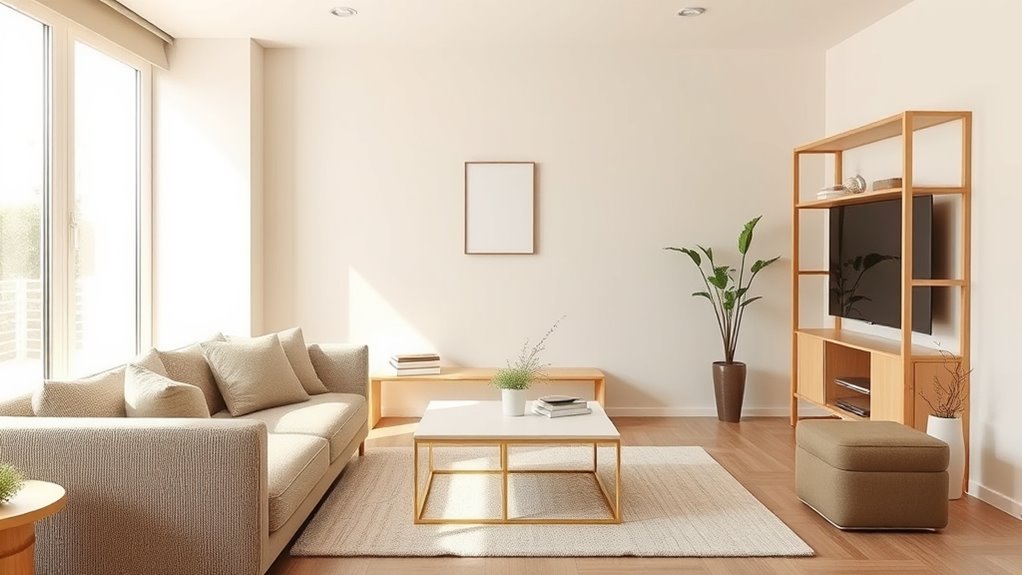
Have you considered how a cohesive neutral color palette can transform your small living room? Using a consistent color scheme, like shades of white, cream, beige, and soft gray, creates a seamless flow that visually expands the space.
Light-colored walls and furniture reflect natural light, making the room feel brighter and larger. Repeating neutral hues across walls, furniture, and decor enhances unity and prevents visual clutter, fostering a sense of openness.
To add interest without overwhelming the space, incorporate subtle contrasting accents, such as textured pillows or artwork, within the neutral palette. This cohesive design approach not only boosts the room’s visual appeal but also helps define zones, making your small living room feel more spacious and inviting.
Define Spaces With Strategic Layouts and Rugs

Strategically placing area rugs can instantly define different zones within your small living room, making the space feel more organized and functional. Using rugs to create visual separation helps establish clear spatial boundaries in an open-concept layout.
Strategic rug placement defines zones, organizing your small living space with style and clarity.
Position rugs under key furniture pieces, like your sofa or dining table, to anchor each zone and guide movement. Layering rugs with contrasting textures or patterns adds visual interest and emphasizes zone delineation.
Choosing appropriately sized rugs ensures they fit the space without overwhelming or shrinking the room’s proportions. Proper placement and size of rugs enhance your furniture arrangement, making each area distinct yet cohesive.
This approach maximizes space and improves flow while maintaining an open and inviting atmosphere.
Select Multi-Functional and Small-Scale Furniture
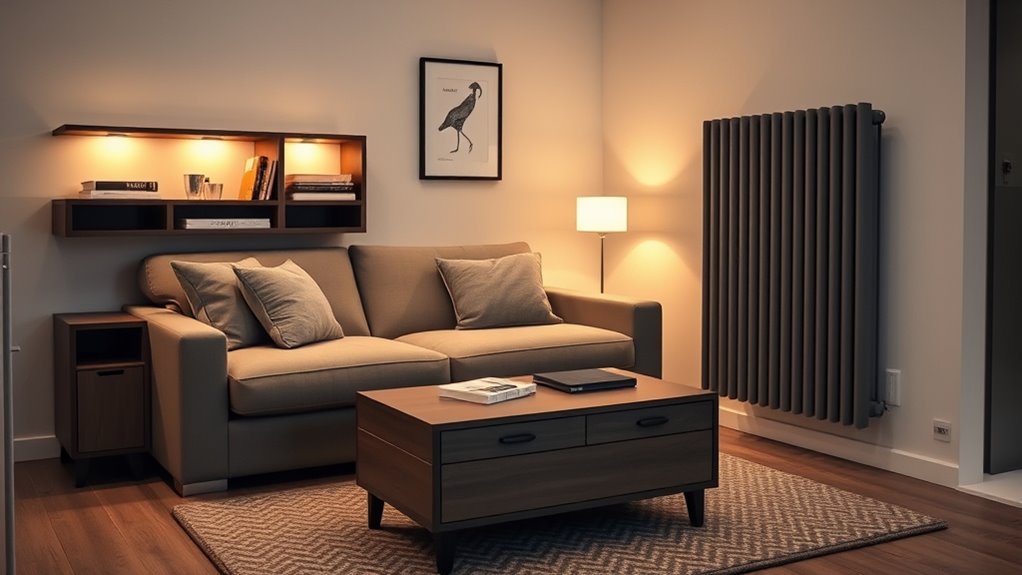
To make the most of limited space, choosing multi-functional and small-scale furniture is essential.
Multi-functional furniture, like ottomans with hidden storage or sofa beds, maximizes utility while conserving space.
Small-scale furniture with sleek, minimal lines—such as slender chairs and low-profile tables—helps avoid visual clutter and makes the room feel more open.
Opt for pieces with built-in storage, like coffee tables with drawers or storage benches, to reduce the need for extra units.
Foldable or extendable tables provide flexible dining or workspaces that can be tucked away when not in use.
Selecting versatile furniture that combines both aesthetic appeal and practicality ensures a balanced, efficient layout, making your small living room feel larger and more functional.
Enhance Natural Light and Layered Lighting
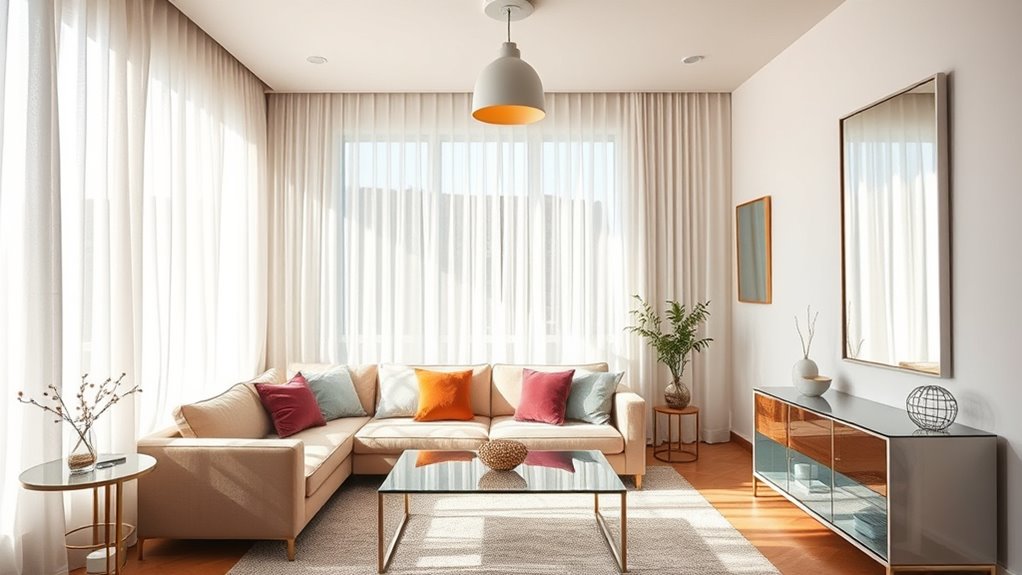
Maximizing natural light is key to making a small living room feel more spacious and inviting. Use sheer curtains or minimal window treatments to let sunlight flood the space, enhancing the sense of openness.
Maximize natural light with sheer curtains and minimal window treatments to create a brighter, more spacious living area.
Position your seating near windows to take full advantage of natural light, creating a warm, welcoming atmosphere.
Incorporate reflective surfaces like mirrors, glass tables, or metallic decor to bounce light around the room and amplify brightness.
Layer your lighting with ambient fixtures, wall sconces, and tall lamps to add flexibility and depth, especially when natural light diminishes.
Choose light-colored walls, furniture, and decor to reflect and amplify the natural light, further enlarging the visual space.
These strategies combine to create a bright, airy, and spacious small living room.
Frequently Asked Questions
How to Maximize Space in a Small Living Room?
To maximize space in your small living room, choose furniture with open frames like armless chairs and leggy tables to keep it airy. Use tall shelves and wall-mounted storage to free up floor space.
Stick to light, neutral colors to make the room feel bigger. Arrange seating to face focal points, create cozy zones, and leave clear pathways.
Add multi-functional pieces like storage ottomans to boost utility without clutter.
What Is the 2/3 Rule Sofa?
They say, “Less is more,” and the 2/3 rule sofa proves it. You place your sofa so that two-thirds of your room’s length is dedicated to seating, creating balance and flow.
This keeps your space from feeling cramped or empty. Remember to leave 18-24 inches around it for easy movement.
Follow this guideline, and your living room will feel both spacious and inviting, even in a small area.
How to Arrange Seating in a Small Living Room?
To arrange seating in a small living room, start by placing two similar-sized sofas or chairs facing each other to encourage conversation.
Use a sectional or L-shaped sofa along a wall to save space and define zones.
Add multi-functional furniture like storage ottomans.
Position seating near windows or focal points for natural light.
Keep furniture slim and leggy to prevent clutter, making the room feel open and inviting.
How Do You Make a Small Living Room Look Bigger?
Did you know that reflecting natural light can make a room appear 40% larger? To make your small living room look bigger, use light, neutral colors on walls and furniture for an airy feel.
Incorporate mirrors opposite windows to bounce light around. Choose transparent furniture to reduce visual clutter, and arrange pieces away from walls to create cozy zones.
Layer lighting and maximize sunlight to brighten and expand your space effortlessly.
Conclusion
By applying these small living room layout ideas, you’ll transform your space into a functional, stylish haven. Remember, a well-designed room isn’t just about furniture—it’s about creating harmony and maximizing every inch. As the saying goes, “A place for everything, and everything in its place.” With thoughtful planning and clever solutions, you’ll make your small space feel bigger and more inviting, proving that smart choices can truly make a difference.
